Anyone who has camped knows: boiling water outdoors requires more than just a container and a fire. You need efficiency to avoid wasting resources, control over the fire—even in wind or rain—and safety to protect the environment and people. The Kelly Kettle is an ingenious solution that has stood the test of time and has become one of the most efficient and iconic pieces of outdoor equipment. Its story dates back to the 1890s, and its use remains relevant today, with applications in bushcraft, survival, camping, fishing, outdoor education, emergency situations and, for some, trekking.
In this article, we’ll explore the history of this revolutionary kettle, how it works, its advantages and limitations, practical applications, and why it was featured in the Gear Tips Cozinha Outdoor course.
The history of the Kelly Kettle: from a rural workshop to worldwide fame
The first Kelly Kettle was created by Patrick Kelly at the end of the 19th century on a small farm on the shores of Lough Conn in western Ireland. As a farmer and fisherman, he was looking for an efficient way to boil water while fishing on cold days. After testing several tin models, which would burn out with frequent use, he began producing his kettle in copper, making it more durable.
The kettle quickly spread among local fishermen and visitors from the UK. The model was custom-made and came in a single size — equivalent to today’s Base Camp 1.6 L.
From father to son
In the 1950s, Jim Kelly (Patrick’s son) became a renowned guide and fisherman on the lake. He always carried his kettle and was known for boiling water at an impressive speed, even on rainy and windy days. For decades, the kettle’s use became a local tradition, with fishermen gathering to share a hot drink.
In the 1970s, Padraic Kelly, the creator’s grandson, started small-scale production and added the Trekker model (0.6 L). The rise in tourism meant that more European fishermen took the kettle home, spreading its fame across Europe.
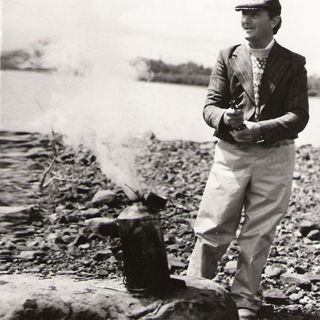
Padraic Kelly boiling water in 1975
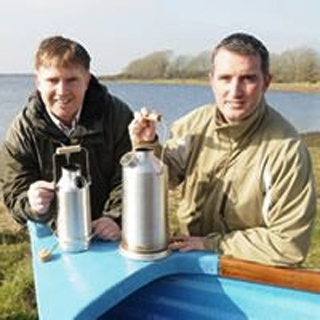
Seamus and Patrick Kelly
The new generation and the stainless steel gamble
In 2005, Patrick and Seamus Kelly took over the company and, facing declining demand for aluminum, decided to mortgage their homes and invest in producing stainless steel models. This bold move saved the brand. Over time, they launched new sizes, complete kits and accessories, solidifying Kelly Kettle as a global reference in outdoor boiling and cooking.
Today, Kelly Kettle is used on every continent by fishermen, mountaineers, scouts, educators, kayakers, survivalists, and nature lovers.
How the Kelly Kettle works: natural engineering
The Kelly Kettle’s surprising efficiency is no accident — it’s the result of an intelligent design that channels air and heat optimally. Each part of the kettle is designed to maximize combustion, make the most of natural materials available on-site, and deliver boiling water in minutes, even in harsh conditions. In short, the secret of Kelly Kettle’s efficiency lies in its design:
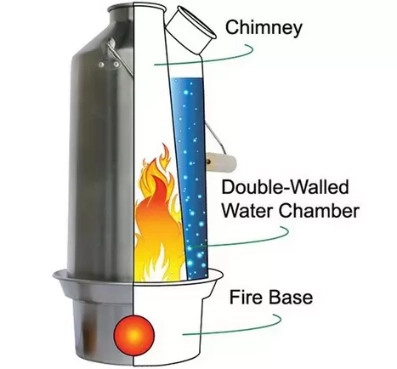
- The fire base concentrates the heat;
- The central chamber (chimney) creates a strong chimney effect, drawing in cold air through the base inlets and constantly feeding the fire with oxygen, which boosts the flame’s power and burning efficiency. This principle is the same used in rocket stoves, small stoves (and even household stoves) that use forced air flow to generate cleaner, more efficient combustion with just a few twigs and lots of heat in little time;
- The water is heated by the entire internal chimney surface, speeding up the boil.
This setup:
- Uses any natural material as fuel: twigs, pinecones, dry leaves, grass, tree bark;
- Works even in wind, rain, or snow;
- Boils water for 3 to 5 minutes;
- Does not require commercial fuels (gas, alcohol, etc.).
Want to see how it all works inside? Watch the video “Anatomy of the Kelly Kettle” (in English) and understand each technical detail of this classic piece of equipment:
Models and specifications: which one is right for you?
The Kelly Kettle has evolved over generations and is now available in different sizes, materials, and accessory combinations. Each model caters to specific usage profiles — from solo adventurers to families or groups in structured campsites. Check out the main options and choose the one that best fits your way of experiencing nature.
\[ninja\_tables id=”34278″]
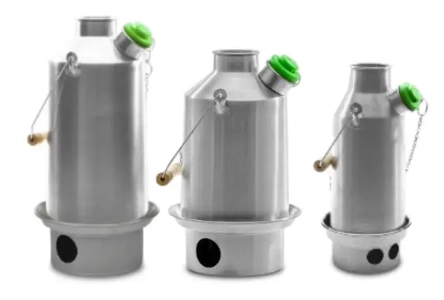
- Stainless steel base;
- Green whistle (the kettle’s lid);
- Drawstring carry bag;
- 2-year warranty.
Materials used in the Kelly Kettle
Anodized Aluminum (1020)
Anodizing is an electrochemical process that creates a protective oxide layer on the aluminum surface, making it harder, scratch-resistant, and corrosion-resistant. It’s a lightweight option, ideal for those who want to reduce weight without sacrificing durability. The number 1020 refers to the base aluminum alloy used — sturdy and with good thermal conductivity.
304 Stainless Steel (Food Grade)
304 stainless steel is one of the most widely used food-grade stainless steels. It combines high rust resistance, easy cleaning, and food safety, without altering taste or releasing residues. It’s slightly heavier than aluminum but much more durable in the long term.
Accessories and kits
The Kelly Kettle goes far beyond quickly boiling water. To make the equipment even more versatile in different situations — whether camping with family, fishing, practicing bushcraft, or preparing for emergencies — the brand has developed a complete line of integrated accessories and kits.
These items allow you to turn the kettle into a complete outdoor cooking system, combining water boiling, simple meal preparation, quick grilling, and even simultaneous cooking while the water heats. All this in a compact format, as the accessories are designed to fit inside or alongside the kettle, optimizing pack volume.
Check out the main add-ons and how they enhance the user experience:
- Hobo Stove: turns the base into a stove;
- Cook Set: pot, frying pan/lid, grill, pot gripper;
- Pot Support: allows cooking with a pot over the chimney;
- Camping Cups: 350 ml and 500 ml mugs with folding handle and silicone lip protector (to avoid burning your lips);
- Camping Plates: stainless steel plates;
- Combined kits: complete versions for transport and use.
Everything can be carried inside the kettle itself. If you want to see how, watch this video (in English):
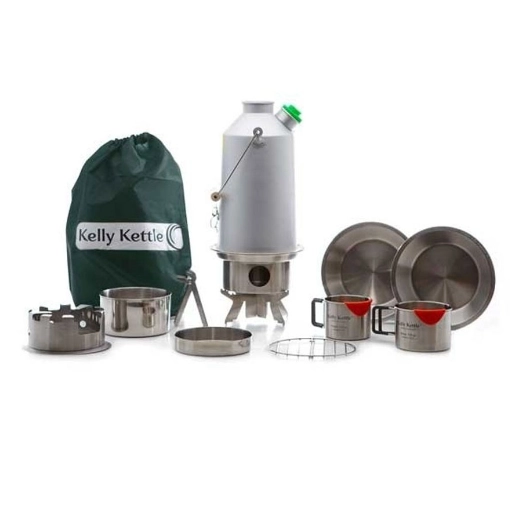
Ultimate Base Camp Kit
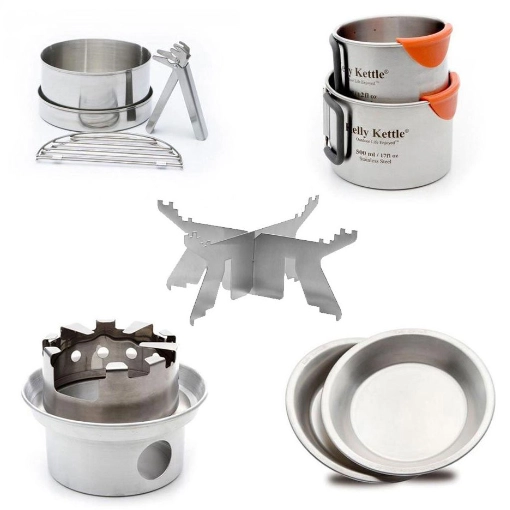
Accessories of the Ultimate Base Camp Kit
Kelly Kettle in the Gear Tips Cozinha Outdoor course
In the Cozinha Outdoor course by Gear Tips, we aim to present participants not only with food preparation techniques but also with smart solutions for self-sufficient, low-impact cooking in natural environments.
Within this approach, the Kelly Kettle became one of the main teaching tools to demonstrate how to boil water quickly for preparing freeze-dried meals or a tea or coffee, using natural fuel collected locally, without relying on gas canisters or traditional campfires.
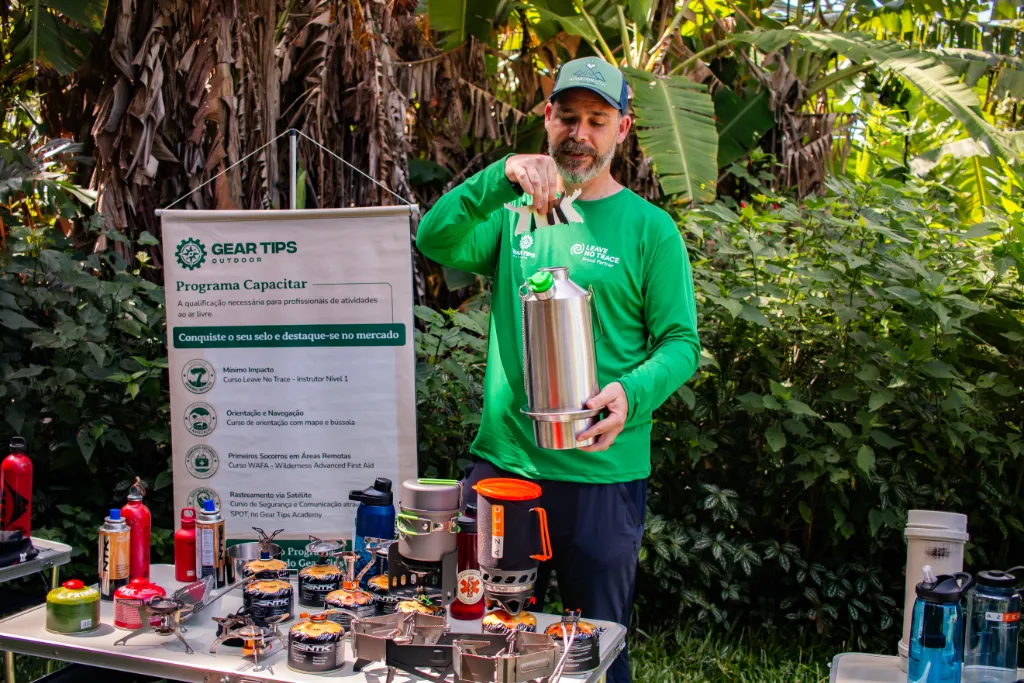
Me presenting the Kelly Kettle in the Cozinha Outdoor course. Photo: Taísa Maar
Besides learning how to handle the equipment, students could observe firsthand the design’s efficiency and reflect on its application in different contexts: from a structured campsite to emergency situations where fuel autonomy can be crucial.
The reactions were immediate and positive:
“The kettle is really impressive! While heating the water, you cook, and then serve everyone without burning yourself. It’s very easy to handle and even comes with a little stove on top, plus other add-ons,” Kelson Tavares
“We saw a kind of kettle that boils water while also preparing another food. You feed it with twigs, you don’t necessarily need gas. You make a mini campfire inside the device safely. I found this equipment very innovative,” Danielle Hopner
The model used was the Base Camp in aluminum, with the complete kit (hobo stove, cook set, pot support, cups, and plates).
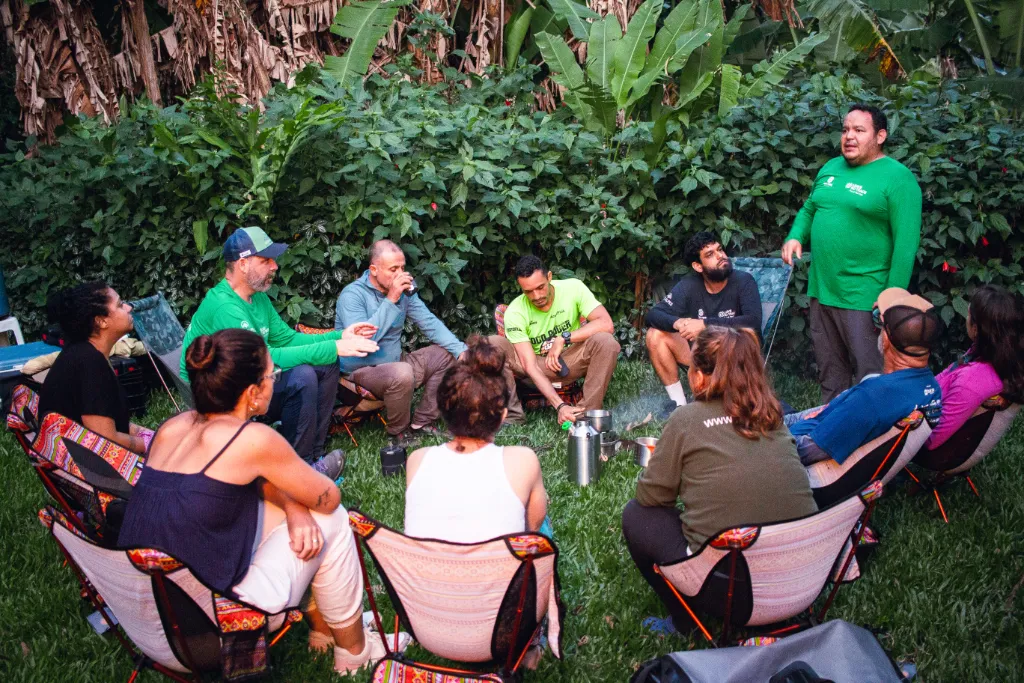
Tea time around the Kelly Kettle. Photo: Taísa Maar
This course is an immersive, hands-on experience for adventurers, expedition guides, and enthusiasts who want to improve their culinary skills in outdoor settings. During the course, you’ll learn how to plan menus, prepare creative dishes, and execute complete meals in real camping conditions, with a focus on low-impact techniques and sustainability.
Kelly Kettle and Leave No Trace Principle 5
Principle 5 — Minimize Campfire Impacts — advises that, whenever possible, traditional campfires should be avoided, as they leave permanent marks on the ground, consume natural resources, and can cause wildfires.
The Kelly Kettle is an excellent alternative when fire is necessary to boil water or prepare simple meals, as it practically demonstrates how to reduce impacts and increase safety. That’s why we’ve included it as an example in the Leave No Trace Instructor Level 1 courses, showing participants how it’s possible to use fire in a controlled, efficient, and low-impact way.
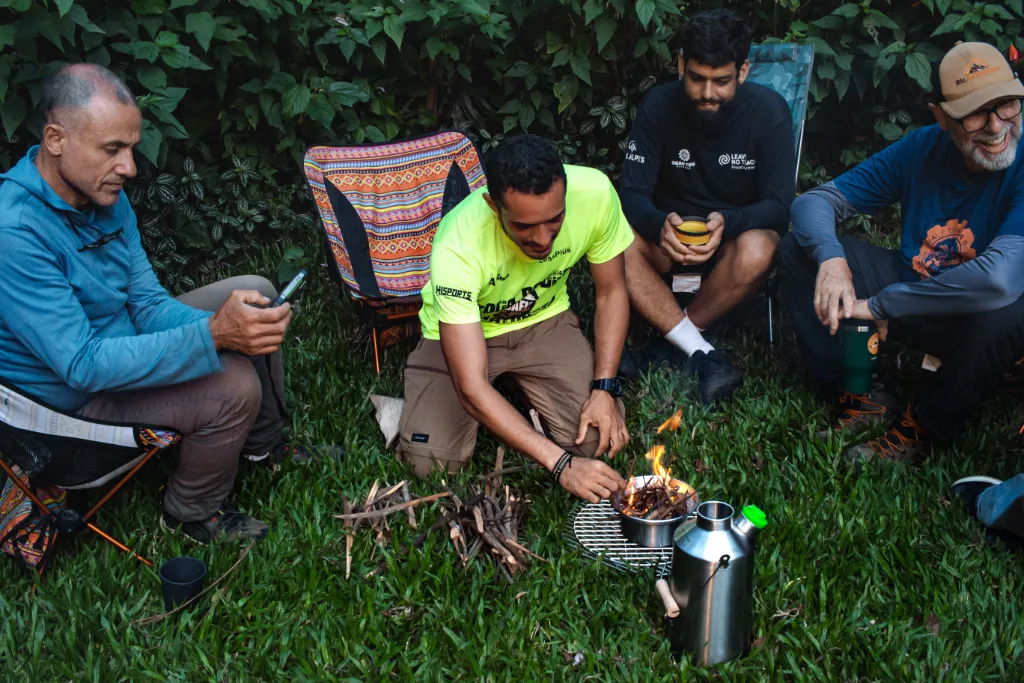
Kelly Kettle Base Camp in use during the Cozinha Outdoor Course. Photo: Taísa Maar
Why the Kelly Kettle fits well with Principle 5:
- Concentrates the fire inside the base and chimney, avoiding stray embers and widespread heat.
- Requires minimal biomass, reducing the need to collect dead wood from the environment.
- Produces little ash and residue, which can be disposed of responsibly after use.
- Works even in windy, wet, or drizzly conditions, where a conventional campfire would be unfeasible or dangerous.
Thus, the Kelly Kettle does not replace the principle of avoiding fires — but it’s a practical (and educational) example of how, when fire is truly needed, it can be managed much more responsibly.
Strengths and limitations
Advantages:
- Very high energy efficiency, using little biomass.
- Independence from commercial fuels — you just use what nature provides.
- Boils water quickly, even in wind, rain, or snow.
- Robust, durable design with no fragile parts.
- Ideal for bushcraft, survival, structured camping, emergency preparedness, and environmental education.
Limitations:
- Bulkier and heavier than ultralight systems — not the best choice for minimalist or long-distance trekking.
- In continuous rain or very damp environments, you may need to plan for dry biomass collection or carry spare fire starters to ensure efficient operation.
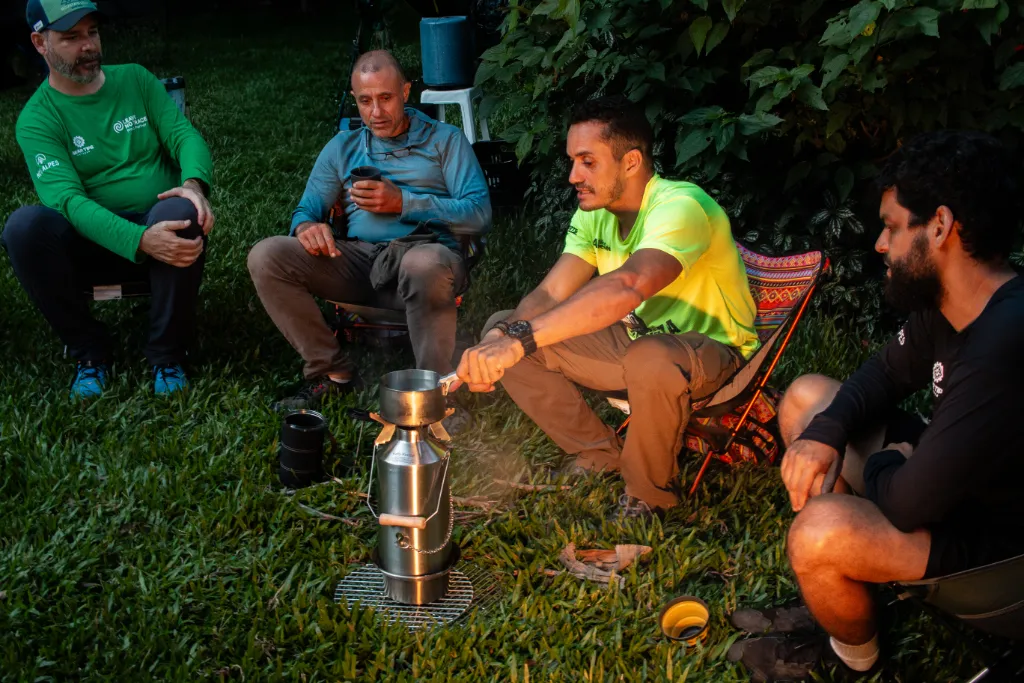
Final considerations
The Kelly Kettle is a timeless piece of equipment: it combines efficiency, natural engineering, environmental responsibility, and family tradition. Whether on remote expeditions, in emergency situations, or at family picnics, it’s a reliable, safe option that doesn’t depend on commercial fuels.
It’s a tool that educates, connects you with nature, and brings back the essence: boiling water, making tea, and sharing the warmth of a flame with simplicity.
Kelly Kettle: from Ireland to the world — with fire, efficiency, and soul.
This post is also available in: Português (Portuguese (Brazil)) Español (Spanish)
